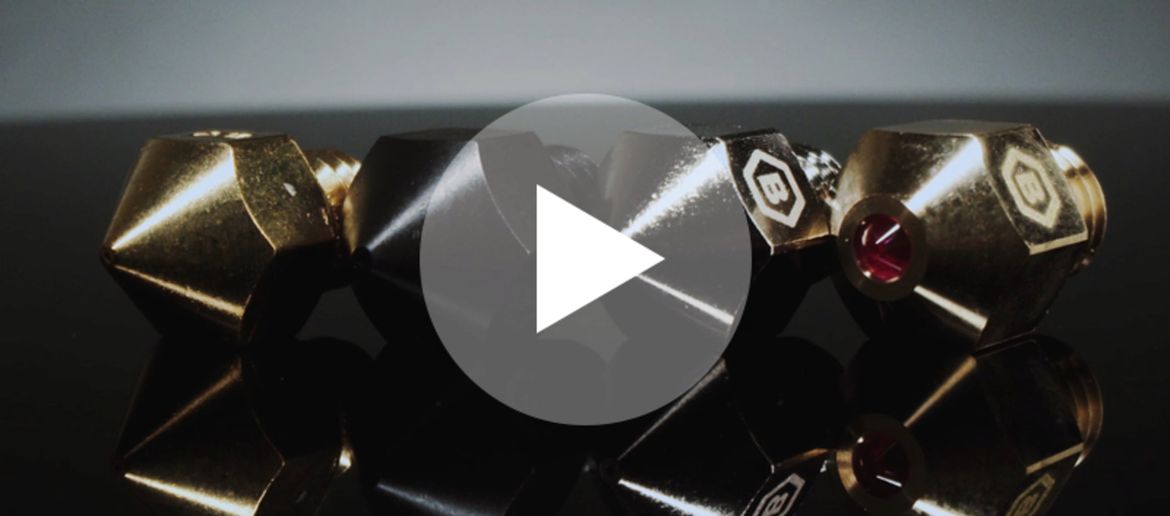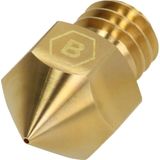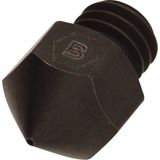3D Printer Nozzle Guide
Everything you should know about 3D printer nozzles
When dealing with the topic of 3D printing, there is a lot to consider. Before you just start printing, you should look into the possibilities and settings of your 3D printer in order to achieve the best possible printing results and to preserve the service life of the device. An important and often underestimated part of the 3D printer is the printer nozzle, which is often given little attention. Even if the nozzle of a 3D printer is a very small component, it has a significant influence on the printing speed and quality.
In this comprehensive guide, we would like to explain to you what a 3D printer nozzle is, how different nozzle types differ and how to choose the right nozzle for your requirements.
Under this post you will also find our new YouTube video, in which we summarize the advantages and disadvantages of different nozzle types and show how you can easily and easily change the nozzle on your 3D printer.
What is a nozzle and what is it used for?
Nozzle are located on the hotend and it is through which the heated filament is printed on the printing platform. With most 3D printers, the nozzle can be exchanged. Depending on the requirements, changing the printer nozzle can be very worthwhile, so you should dare to try different nozzles.
How do 3D printer nozzles differ?
A basic distinction is made between 3D printer nozzles based on the following properties:
- Nozzle diameter
- Material
Depending on the material and nozzle diameter, the nozzle meets different print requirements.
Nozzle diameter
3D printer nozzles are available in different nozzle diameters from 0.1 to 2.0 mm. The diameter of a nozzle also determines the possible layer height and thus indirectly the printing speed, because:
Basically, it's about how much filament is extruded and how fast.
As a rule, the maximum layer height values should not exceed 80% of the nozzle diameter. For example, a 0.4 mm nozzle has a recommended maximum layer height of 0.32 mm.
If you want to know what maximum and minimum layer height you can print with your nozzle, use the following rule of thumb:
|
⇒ Maximum layer height = 0.75 * nozzle diameter ⇒ Minimum layer height = 0.25 * nozzle diameter |
0.4 mm nozzle as standard
For most 3D printers, the 0.4 mm nozzle has become the standard, as it is usually installed as standard and offers a good balance between resolution, precision and printing speed.
Small nozzles <0.4 mm
Small nozzles are ideally suited for the production of objects with very fine, precise details and barely visible layer traces.
Since the nozzle diameter is so small, the printing times are longer than, for example, with a 0.4 mm nozzle. In addition, special materials, such as filaments with particles, cannot be processed with small nozzles. The risk of clogging the nozzle is also much higher than with larger nozzles.
Large nozzles> 0.4 mm
Large printer nozzles ensure a higher material flow, thicker layer heights and reduced printing times. The wider extrusion and the higher layers give the printed models more stability, but they are not as finely printed and are not rich in detail. In addition, wider nozzles hardly clog and are therefore ideal for special materials such as wood, carbon fibre or glow-in-the-dark filaments.
Due to the fast possibility of printing, large nozzles are particularly recommended for rapid prototyping.
|
⇒ Fact: When printing with a layer height of 0.4 mm, the printing time is almost halved compared to a layer height of 0.2 mm. |
Nozzle materials
Due to their relatively high thermal conductivity, 3D printer nozzles are made of different metals that influence the 3D printing process in different ways. Since some filaments have abrasive properties and therefore certain types of metal wear out faster than others, the nozzle material should be selected accordingly.
In the following, we will list the different nozzle materials with their advantages and disadvantages in order to create an overview of their abilities.
- Brass nozzles
→ max 300 ° C.
Brass is the most commonly used material for 3D printer nozzles. It offers excellent heat transfer at a relatively low cost. When processing abrasive special filaments with wood, carbon or metal fibres, however, a brass nozzle wears out very quickly and becomes imprecise.
In order to protect the relatively soft nozzle material from excessive abrasion and to reduce the friction between the filament and the nozzle, a brass nozzle can be coated with nickel or chrome.
Advantages
- Low cost
- High thermal conductivity
Disadvantages
- Low wear resistance
- Not suitable for highly abrasive materials
- Coated nozzles
→ max 500 ° C.
In order to protect relatively soft nozzle material from excessive abrasion and to reduce the friction between the filament and nozzle, brass or copper nozzles are also available with a nickel or chrome coating.
In addition to the improved scratch resistance, a coating also significantly increases the temperature resistance of the nozzle.
Advantages
- Higher wear resistance than normal brass or copper
- Perfect all-rounder
- High-temperature resistance
- High thermal conductivity
Disadvantages
- Not as hard as hardened steel
- Not suitable for permanent use with abrasive materials
- Stainless steel nozzles
→ max 500 ° C.
Steel is another popular material for nozzles because it offers slightly better wear resistance than brass nozzles. They also, to some extent, prevent molten plastic from sticking to its surfaces and contaminating the print with lead, which is often the case with brass nozzles. Steel nozzles are therefore theoretically suitable for food-safe materials.
Steel allows a wider range of filaments to be processed but is not recommended if abrasive filaments are used frequently. It is also less heat-conductive compared to brass.
Advantages
- Better wear resistance than brass
- Can be used for food-safe filaments
Disadvantages
- Lower thermal conductivity than brass
- Lower wear resistance than hardened steel
- Hardened Steel Nozzles
→ max 500 ° C.
Hardened steel nozzles are a useful 3D printer upgrade as they are tough enough for frequent use of abrasive materials (10 times more wear-resistant than brass nozzles) and literally offer years of use without replacement.
However, this material has an even lower thermal conductivity than the two previous materials and is more expensive to purchase. Since the inner surface of the nozzle is not as smooth as other “softer” nozzle materials, this can result in poor print quality.
Advantages
- High wear resistance
- Very durable
- Suitable for abrasive materials
Disadvantages
- Lower thermal conductivity
- Lower print quality
- Higher cost
- Ruby Nozzles / Brass Ruby Nozzles
→ max 550 ° C.
Nozzles with ruby tips belong to the luxury class of 3D printer nozzles. As a rule, ruby nozzles are brass nozzles with or without a coating that have a ruby on the tip. Since the hole in the ruby can be made very precisely, there are only small diameter tolerances.
The ruby tip of the nozzle ensures additional wear resistance, which is particularly useful when processing special filaments. Compared to the other types of nozzles, the ruby nozzle is the most expensive.
Advantages
- High thermal conductivity due to the brass body
- High wear resistance
- High-temperature resistance
Disadvantages
- Higher cost
Changing the 3D printer nozzle - this is how it works
Would you like to exchange your 3D printer nozzle? In our video we show you exactly what to look out for when replacing the 3D printer nozzle.
We would be happy if you visit us on YouTube and leave a like or comment. If you want to see something specific on our channel in the future, please let us know in the comments!
Related products
Magazine Articles:
Discover 3DJake:
-
Delivery in 3 business days.
More than 10.500 products
We deliver worldwide to
more than 40 countriesSecure payments
with SSL encryption technology





